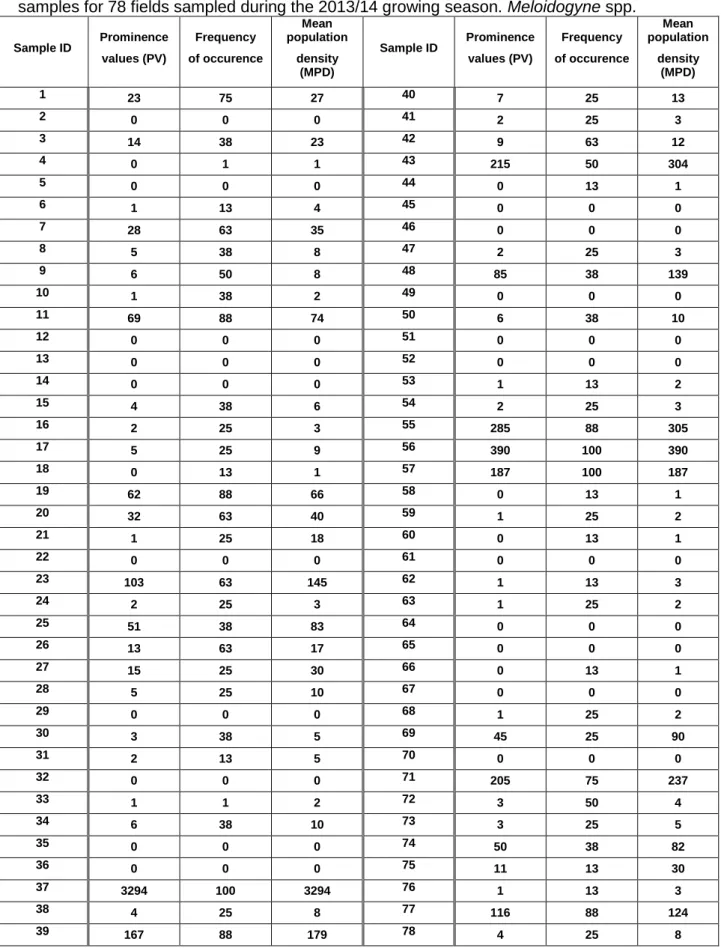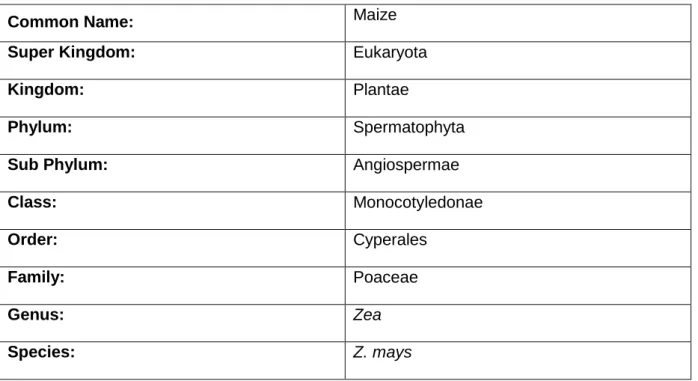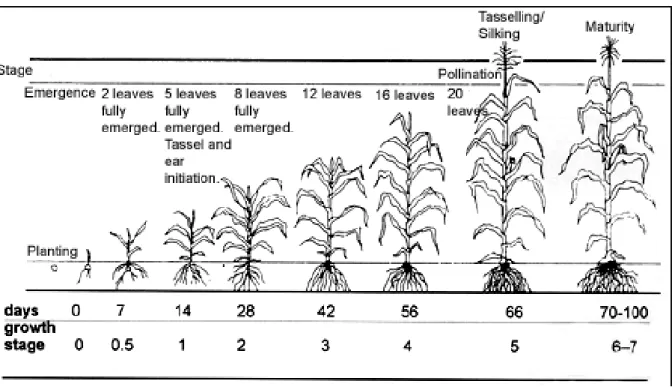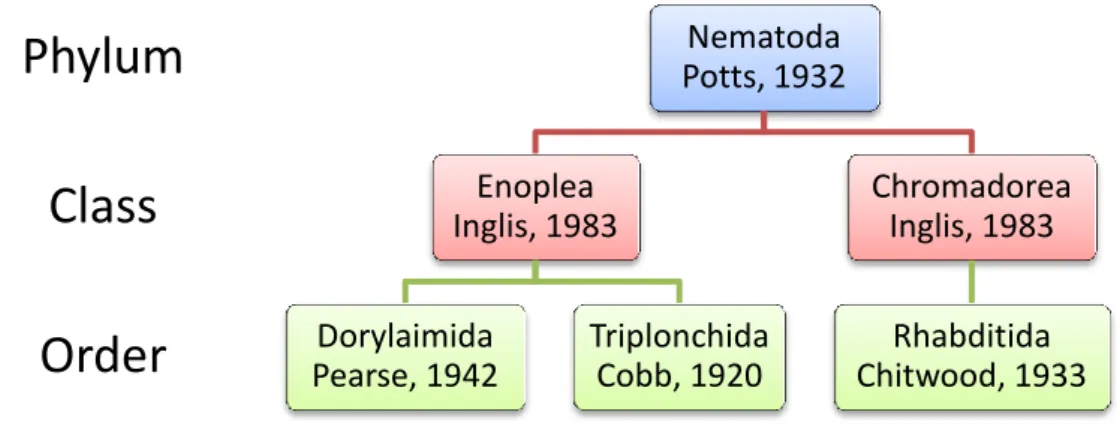Although Pratylenchus spp. were initially considered the most economically important plant-parasitic nematodes of maize. Population development of Meloidogyne spp. in a susceptible maize cultivar and the effect of a seed treatment on the reproduction of this nematode genus.
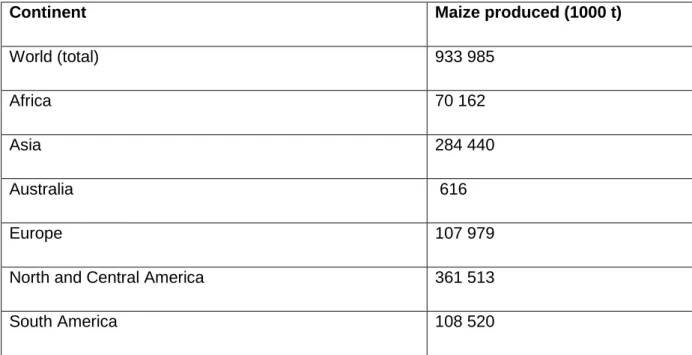
Origin and history
Classification
Maize plants can reach heights of up to 4 m (Du Plessis, 2003). The stem of a maize plant is divided into nodes and internodes and generally contains eight to 20 leaves (Fig. 1.2) arranged spirally and alternately in two opposite rows. . 6 From planting a maize kernel (which represents Growth Stage 0) onwards, the plant follows through different growth stages until it reaches physiological maturity (Growth Stage 7).
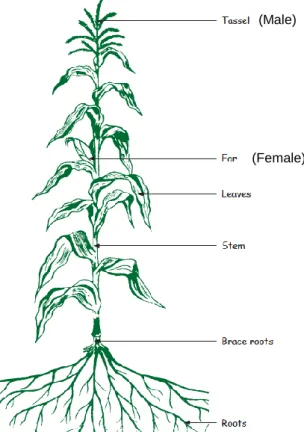
Adaptation, production potential and practices
In South Africa, over 80% of maize crops are produced under rainy conditions (where rain is the only source of water), while just under 20% are grown under irrigation (where maize fields receive rain and additional water from nearby water sources). water sources such as dams or rivers). The planting depth of corn seeds varies from 5 to 10 cm, depending on the type of soil and planting date.
Harvesting
Production constraints
General classification
Plant-parasitic nematodes penetrate the cell walls of the host tissue with a stylet located in the anterior end (head) of their bodies. There are three stylet types in plant-parasitic nematodes, namely a stomatostylet (Tylenchida, to which Meloidogyne belongs), an onchiostylet (Triplonchida) and an odontostylet (Dorylaimida).
Plant-parasitic nematodes associated with maize
The female root-knot nematode can produce hundreds to thousands of eggs during her lifetime (Karssen et al., 2013). Root-lesion nematodes are considered the second most economically important genus of plant-parasitic nematodes worldwide (Jones et al., 2013).
Identification of nematodes
An early example of using DNA-based methods, more specifically restriction fragment length polymorphisms (RFLPs), was published by Curran et al. This issue eventually led to the use of PCR via hybridization-based approaches of the RFLP method to isolate Meloidogyne spp.
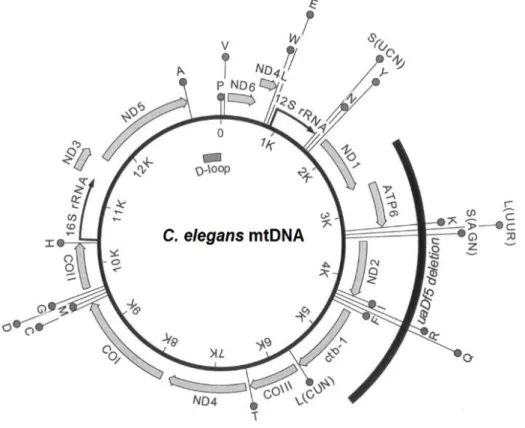
Management of Meloidogyne spp
29 Very important for effective cultural control is that the initial population density (Pi) of the target nematode is known (Nyczepir & Thomas, 2009; Coyne et al., 2009). Therefore, this product is considered more environmentally friendly and cost-effective than Class I nematicides (Cabrera et al., 2009).
Hypothesis and aims of this study
Preventing the introduction and spread of plant parasitic nematodes (Moens et al., 2009; . Karssen et al., 2013) in cultivated fields is an important first step to alleviate damage. Plant Health https://www.apsnet.org/edcenter/intropp/lessons/Nematodes/Pages/LesionNematode.aspx Date accessed: 22 May 2015. Toward specific diagnosis of plant parasitic nematodes using DNA-oligonucleotide microarray technology of: a case study with the quarantine species Meloidogyne chitwoodi.
First report of outbreaks of the fall armyworm Spodoptera frugiperda (J E Smith) (Lepidoptera, Noctuidae), a new invasive alien pest in West and Central Africa. 2016) First report of outbreaks of the fall armyworm Spodoptera frugiperda (J E Smith) (Lepidoptera, Noctuidae), a new invasive alien pest in West and Central Africa. Distribution and genetic diversity of root nematodes (Meloidogyne spp.) in potatoes from South Africa.
Introduction
45 Deoxyribonucleic acid (DNA)-based techniques are rapid and generally more reliable than morphological identification (Adam et al., 2007). Although several molecular techniques are used nowadays to identify Meloidogyne spp., sequence-characterized amplified region-based polymerase chain reaction (SCAR-PCR) is a powerful, accurate and rapid technique (Zijlstra, 2000 ; Zijlstra et al., 2000; Blok and Powers, 2009; Subbotin et al., 2013). Regarding Pratylenchus, the dominant species associated with local maize crops are Pratylenchus zeae Graham, 1951, followed by P.
In addition to Meloidogyne and Pratylenchus spp., a wide range of other plant parasitic nematode genera have also been associated with local maize crops. Due to i) progressive withdrawal of class I toxic nematicides (Verdoorn, 2012), ii) progressive increase in population density of nematode pests in local maize fields according to diagnostic and research results (Bekker et al., 2007) and iii ) , the previous formal nematode-maize survey done almost 30 years ago (De Waele and Jordaan, 1988) there was a need to re-evaluate the status and identity of plant parasitic nematodes (especially that of Meloidogyne spp.) dominant in the south. African maize production areas.
Materials and methods
Survey
- Roots (5 g and 50 g)
49 Table 2.1 The 78 maize fields sampled for a nematode study during the 2013/2014 growing season, with information on the production practices of the respective producers and data on selected soil characteristics. 53 Table 2.2 Average precipitation and temperature figures for the 78 maize fields sampled for a nematode study during the 2013/14 growing season. Kaolin is a clay mineral that forms a film and seals the nematodes at the bottom of the centrifuge tube (Coolen &. D'Herde, 1972).
The centrifuge tube, with the nematodes and plant material sealed at the bottom, was then filled with a sucrose solution (624 g sugar / 1000 ml water), the contents were stirred well to break up the kaolin layer and enable the nematodes to to be suspended. This was done to avoid long exposure of the nematodes to the sucrose solution because they could become distorted.
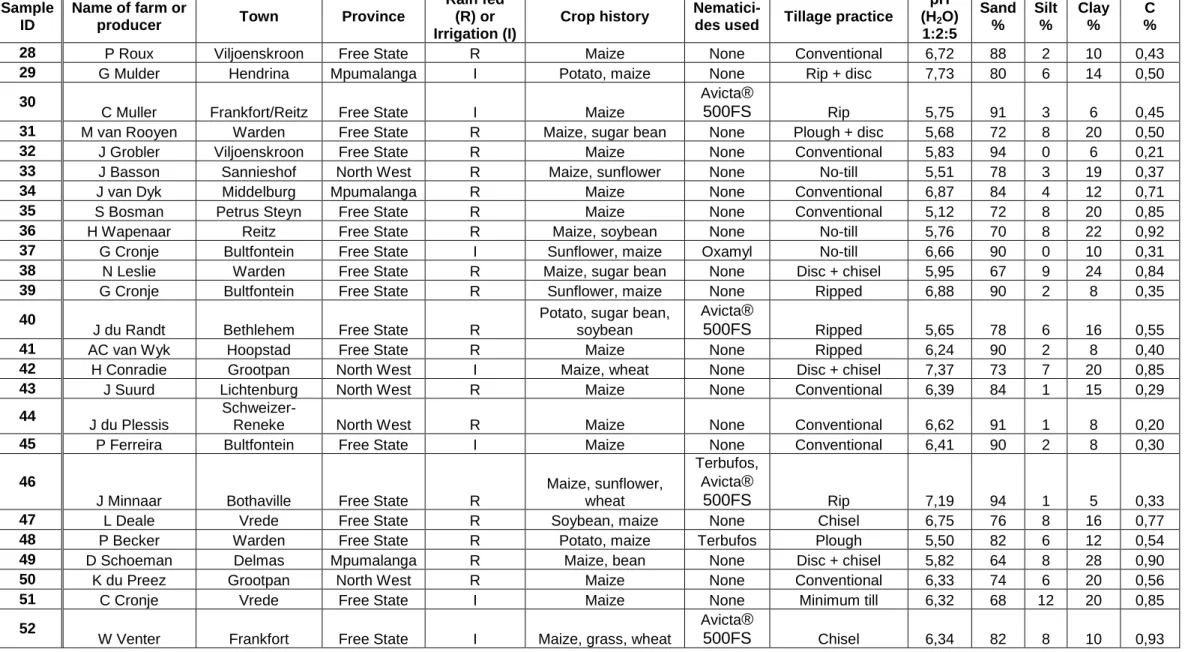
Soil (200 g)
- The adapted decanting and sieving, followed by the adapted sugar-flotation method
55 The entire root system of each maize plant was used to extract Meloidogyne and J2 eggs. The solution containing the roots was decanted onto a series of nested sieves with openings (order from top to bottom: 250 µm; 75 µm, 63 µm and 20 µm) and rinsed with running water for four minutes. The eggs and J2 of each sample were then collected in a 100 ml sampling bottle for counting.
Extraction of deoxyribonuclease (DNA) and polymerase chain reaction (PCR)
- NADH dehydrogenase subunit 5 (NADH5) technique and deoxyribonuclease (DNA) sequencing
- Sequence-derived amplified region – polymerase chain reaction (SCAR-PCR)
Phylogenetic analysis was performed by aligning sequences using the Clustal Using the Maximum Likelihood method (1,000 bootstrap values) as performed in Mega7 software (Kumar et al., 2016). For this specific study, SCAR-PCR assays were performed only to determine the presence of M. A “no template” control (NT- no DNA, containing only water without nuclease) and a known reference sample containing DNA from monoculture populations of each Meloidogyn. spp.
The contents of the PCR tubes were then centrifuged and placed in a C1000™ Thermal Cycler (BioRad) under the conditions described in Table 2.3. Populations of these reference species were previously identified using the SCAR-PCR technique (Fourie et al., 2012).
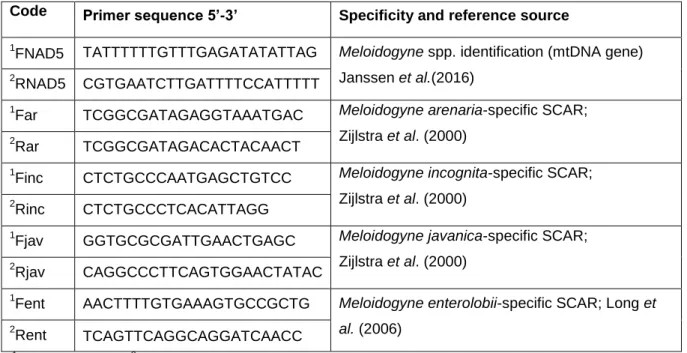
Data analyses
Nematode data .1 Roots (50g)
- NADH dehydrogenase 5’(NADH5) technique
- Sequence-derived amplified region – polymerase chain reaction (SCAR-PCR)
In seven of the fields, Meloidogyne eggs and J2 were absent (0% occurrence) in the root samples. The presence of eggs and J2 of Meloidogyne in 91% of the 50 g root samples obtained from the 78 maize fields sampled is a direct indication of the importance of this nematode genus in local maize production areas. Instead, molecular methods were used to elucidate the identity of the root knot nematode species in maize fields.
Meloidogyne incognita outnumbered the other three species and was present in 99% of the fields attended by M. The presence of Pratylenchus individuals in 99% of the 5-g root samples obtained during this study confirms that this genus is an economically important nematode pest. important maize in South Africa (De Waele & Jordaan, 1988;.
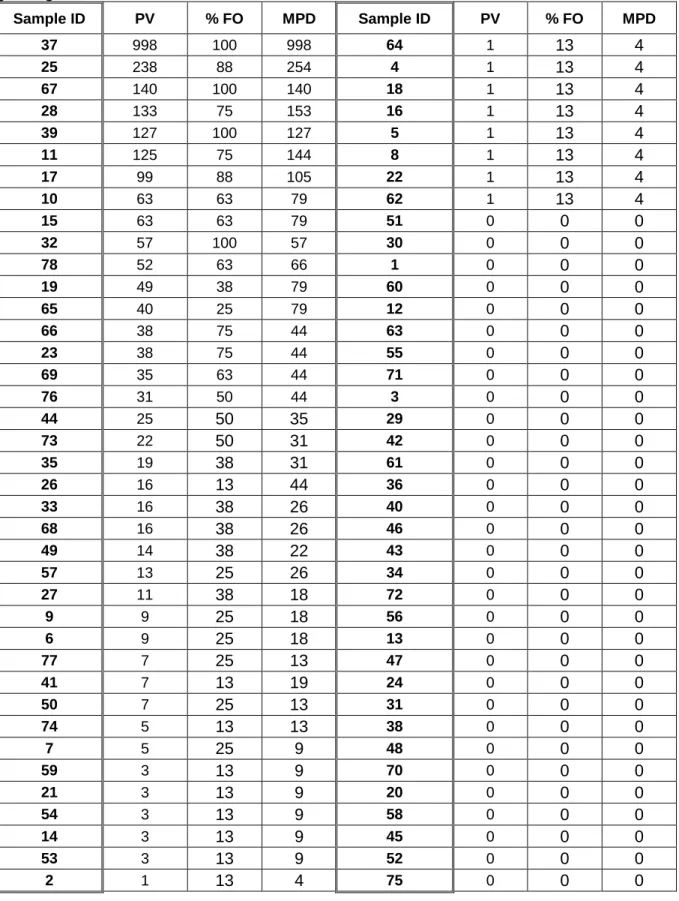
Introduction
A large percentage of local maize crops are grown on sandy soils with a clay content of less than 10% (Du Plessis, 2003). Root nematodes develop and reproduce optimally in such sandy soils (Kim et al., 2017), so it is not surprising that a large percentage of local producers have serious problems with these pests. Therefore, in the last five years, two new generation seed treatment products have been registered on maize in South Africa to protect crops against nematode pests (Van Zyl, 2013; Bayer CropScience, 2014).
This product has a different mode of action (Turner & Schaeffer, 1989) than the synthetically derived nematicides currently available and used successfully to reduce population densities of various plant parasitic nematodes, including Meloidogyne spp. crops (Syngenta, 2017). Therefore, there was a need to quantify i) the ratio between Pi and Pf of individual and mixed populations of M. .. incognita and M. javanica in the roots of a locally sensitive maize genotype and ii), the effect of registered seed treatment on the development of the population of Meloidogyne spp.
Materials and methods
- Micro plot studies .1 Study 1
- Study 2
- Data analyses
- Microplot Study 1
- Root mass
- Microplot Study 2
- Plant data (Root and aerial mass)
Six maize seeds of the root-knot nematode-susceptible cultivar DKC8010 were placed approx. 5 cm deep in a furrow made in each half of each microplot tube. The same amount of irrigation was applied when the topsoil dried until the seeds germinated. The entire root system of each plant was used when reproduction factors (Rfs) were calculated to determine the reproductive potential of the respective Meloidogyne spp.
One hundred ml of tap water was carefully added to the soil surface of each pot every second day to keep the nematodes alive and allow seed germination. No significant interaction was apparent between the two treatments with respect to the root mass of plants infected with the different Pi levels of the Meloidogyne spp.
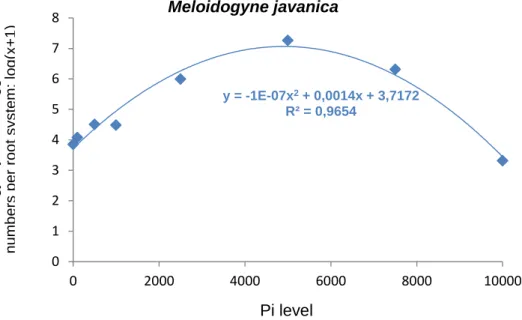
Discussion
The data for both Meloidogyne spp. differs from that by Fourie et al. 2009) showing flattening, and not a decrease, of regression lines for both Meloidogyne spp. The reproductive potential of a mixed Meloidogyne spp. 70:30 ratio) for untreated seed used in the second microplot study was significantly higher than that of either single species of M. However, no literature could be found on the effect of Pi on Pf of mixed Meloidogyne spp. .
Field evaluations with different Pi levels should therefore be performed to draw conclusions on the effect of abamectin on Meloidogyne spp. 101 Since yield data could not be obtained for any of the three microplot experiments performed during this study, correlations could not be drawn between Pi levels and yield for the Meloidogyne spp. 2009), however, showed that yield losses differed significantly for sensitive maize varieties, viz.
Conclusions and recommendations
106 the 68 local populations from which usable DNA could be obtained in the same clade as numerous other thermophilic Meloidogyne spp., which sequences were selected from the NCBI Genbank. One explanation for this anomaly is that improvement of the adapted sodium hypochlorite (NaOCl) method by Riekert (1995) showed that optimal extraction of Meloidogyne spp. The second part of this study focused on elucidating the nature of relationships between initial and final population densities (Pi and Pf, respectively) of the dominant Meloidogyne spp.
Although no literature could be found on the effect of Pi on Pf of mixed Meloidogyne spp. Therefore, no correlation could be drawn between Pi levels and yield for Meloidogyne spp.
